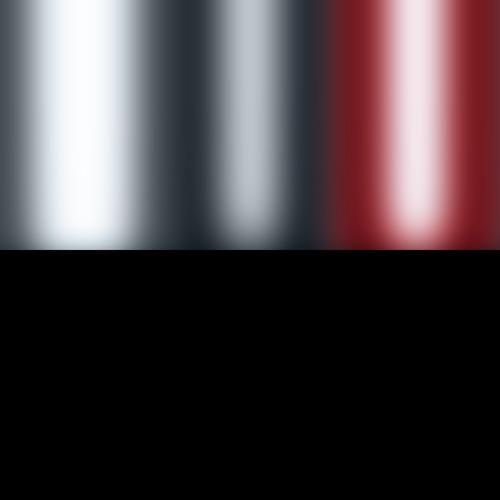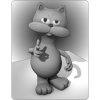IBL - Environment map - Equirectangular - light blue tint with red accent - 3 lights
download : the image shown below (1024x1024)
note : no light coming from below the horizon line
we get some soft shadows at the vase of the objects/figures
--
2nd image shows a Daz Studio 3 scene exported to Blender using mcjTeleblender and rendered through Blender-Cycles


litemeup.jpg
1280 x 720 - 153K


liteup.jpg
1024 x 1024 - 30K
Post edited by mCasual on



Comments
>> ROOKIE ALERT! <<</p>
This is probably very useful.
But I have no idea what it is.
Image Based Lighting, is a bit as if you painted the
attached image ( the one with 3 bright spots ) on a giant sphere
and used this to illuminate the 3d scene
when rendering in Blender-Cycles you can use such an image as a "world environment"
Daz Studio 4.5, has bundled with it a "Uber Environment 2" light
and you can apply an image like that to it ( The image map of the Color parameter of the Light node )
though usually people use HDR images for that purpose
to render this image i did this
- added a uberenviroment2 light to the scene
- selected the uberenviroment2 node,
- applied"Set Quality 4 Hi" to increase the quality
- applied "Set HDR Dawn" to enable Image Based Lighting
- in the parameters tab of the uberenviroment2 light, i changed the image map ( Color ) to the one i'm posting in this forum
- in the surfaces tab of the uberenviroment2 sphere material, i changed the images to the one i'm posting in this forum
- in the parameters tab of the uberenviroment2 sphere i changed the setting "visible in renders" so we can see the "painted" sphere
- i changed the color of the uberenviroment2 light to gray, because the light was too bright
Okay thanks, Casual. So this is for Blender or DS4.5 ... and gives that gradiant effect in the background? (Which looks very effective in your office scene, by the way.)
i added to the post above the instructions about using it with Daz Studio 4.5's built-in "Uber Environment"
and here you can see a little animation rendered in Daz Studio 4.5 using the IBL
it's not just a background, you can see it casts light/color on the scene
i added to the post above the instructions about using it with Daz Studio 4.5's built-in "Uber Environment"
and here you can see a little animation rendered in Daz Studio 4.5 using the IBL
it's not just a background, you can see it casts light/color on the scene
Thanks for posting this. I am always trying to make my own and they don't come out as expected. It looks like from this that I need to use more extreme contrasts and intense color.
Also, this is a jpg. IBL maps are usually 32-bit HDR or TIF, which are supposed to be better. I noticed that they are different but don't seem better, but I don't do professional grade realistic stuff. What is your opinion/observations about using jpgs or higher rez images for IBLs?
I just noticed this! Thanks Casual!
if i understand this correctly, HDR just have 65536 intensity levels, while jpg etc have only 256
i know i had to apply a gray tint to the ''color'' channel because it was coming out too bright
there's some freeIBL/ HDRs at http://www.hdrlabs.com/sibl/archive.html
and at http://zbyg.deviantart.com/art/HDRi-Pack-3-112847728
attached, another IBL image i made, that light map produced good renders
but in the end i think interesting results happen faster if you
create 3 lights ( notably Area Lights ) move them, change their size, tint and intensity
and render ( or real-time preview ) until you get something you like
---
in this case in Blender Cycles ( the scene was exported from Daz Studio using my free mcjTeleblender script
i tried my custom IBL maps but results were boring
so i created 3 panels with Emissive materials
and tweaked and tweaked
[ the pose and scene composition comes from a clothing store
http://www.mms591.com/www.mms591.com-photo/2011083111/1-110S1112559.jpg ]
i'm not really aiming at credible realism either
so it's easier to stay away from the 'uncanny valley'
the second image shows the 3 area lights and the faint blue world environment
the large pink panel has an intensity of 1
the white panel to Amy's right has an intensity of 10 and is quite close
the one to her left has an intensity of 7
the world envuronment has an intensity of 0.25
Thanks for this and the IBl info. Nice soft renders with the area lights!
I will keep plugging along. I like area lights too but using 3 of them is kind of slow with a big scene, and I have a hard time getting them just right too. I am going to try some of the HDRs from the links you provided and see what happens.
Well there are few differences between IBL and Area lights from my understanding. This is just my understanding so feel free to correct me if I'm wrong.
IBL offer more dimensional light characteristics vs a more controlled 'Studio' environment that area lights would, so different expectations/results.
IBL offer much more in the case of reflective surfaces when there aren't a lot of objects in the scene to reflect (the example picture's chrome happens to be such that it does have objects to reflect in this instance.) This can be countered with reflection maps used on the reflective surface but it often doesn't seem to give as good a results on average as IBL, but one's mileage may vary.
On the other hand, area lights would act more like one would expect studio lights to act.
The original image being used as an IBL is a bit simplistic and therefore wouldn't show off the true aspects of IBL in it's intended use but is very useful in demonstrating the basic principles of IBL. It removes much of the complexity a normal IBL would have, thus making more apparent what is actually happening in a fundamental sense.
When I think of IBL, I think of it producing subtle 'noise' in the lighting of the scene, similar to adding noise with a Gaussian blur to the diffuse colors/map does for a texture. The resulting effect takes the overly clean look off of the image to produce a much more realistic environment where things aren't so clean. This means we can use this as a counterbalance between the 'stylized' or toon aspects vs realistic... controlling subtle light, texture, and color noise aspects of our scene.
However, as I said in the beginning... feel free to correct or clarify any of this :)
all you said makes sense to me
in the last few years i often used the "ditch river" map here
http://www.hdrlabs.com/sibl/archive.html
the fact that it's located under a bridge makes interesting lights
the problem with some IBL maps is that light comes from everywhere, and there's not much shadows and highlights left
another issue is that my materials often hadd much gloss, which are also shadow killers
the best is possibly to use IBL for the general ambient light, maybe dim it a bit,
then add smaller area lights to add highlights and sharper shadows
sometimes i add walls/panels to cut out some of the IBL light
Well I tend to use UberEnvironment as a source of ambient light at about 20-40% with other light sources. The other light sources might be as simple as a distant light for a sun, or multiple lights such as torches, streetlights, etc.. So the IBL is by definition being used as a general ambient light in my case.
Here's a different take on HDR ;)
I just started playing with IBL in DS and found this thread. Using DS 4.5.1.6Pro (64 bit) I don't seem to be getting anything on the Surfaces tab. Screenshot attached showing my surfaces tab after completing the first 5 steps as noted above.
Parameters and Lights tab are fine.
Probably missing something obvious - any pointers?
it's something that happens very rarely, but
the image has to be applied to a channel named Color .... in the Parameters tab of the uber...light node
and it can also be applied to the Environment sphere in the Surfaces tab
This can be confusing. Uberenvironment has the parent object and the sphere. The settings you are looking for are on the sphere. Note, as casual said.. it can also be found on the Parameters tab, but this made more sense to me for remembering it.
Thanks Casual/Gedd - so yes I was missing something obvious! Casual's instructions were quite clear (bold red indicates the bit I overlooked)...
And I didn't even spot that little triangle next to 'UberEnvironment2 1' on the 'Scene' tab in my screenshot indicating that the node can be expanded.
Hmmm... I'm 99.9% certain that you need to apply an angular (light probe) map in your fifth step, not a latitude/longitude map like the one in your first post. I've done a few checks and the attached image should hopefully make sense and prove the point (I think the angular map needs to be flipped left/right as well, which I forgot to do for the test
Luckily it's really easy to convert between the two formats using HDRShop Version 1 (version 1 is still free - there's a download link on theHDRLabs tools page here - http://www.hdrlabs.com/tools/links.html ). Converted version of Casual's liteup.jpg from the first post below.
thanks,
i didn't study DS's environment maps in detail, there's the issue of the sphere UV mapping also to consider
the equirectangulat map seems appropriate for Blender-cycles ...
for Blender-Internal-Render's skes and "worlds" i dont know !
and for DS's UberEnvironment light it's very possible that a probe type of map is needed
though, applying an equirectangular image to a probe type of map kinda works :)
... oh lets check the ones supplied with DS4.5 ...
C:\Users\MYUSERNAME\AppData\Roaming\DAZ 3D\Studio3\DAZ Built-in Content\Runtime\textures\omnifreaker\Environment
there's a .tif and a .hdr for each setting, one must go on the sphere the other on the light-node, and they both look like they are equirectangular
unless there's differences in uberenvironment 1 and 2 or between DS3 and 4
Yep, agreed - all the images supplied with the omnifreaker UberEnvironment2 stuff (in both DS3A and DS4) seem to be the equirectangular format - that's why the result of my test surprised me! :)
This IBL stuff is fantastic though, regardless!
{Edit: I think Casual's post here was related to this thread}